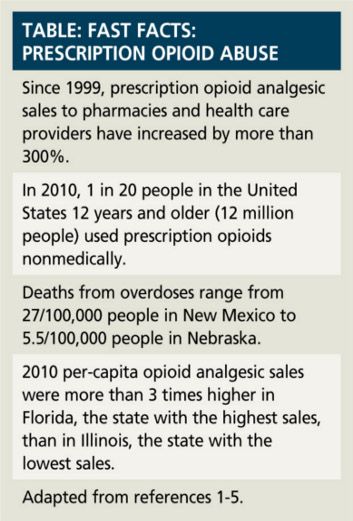Publication
Article
Pharmacy Times
Legal Opioids: An Octopus of a Problem
Author(s):
From individuals and families to states and national agencies, the problem of prescription drug abuse touches all levels of American society.
From individuals and families to states and national agencies, the problem of prescription drug abuse touches all levels of American society.
In the late 1990s, pain relief became a health care priority.1,2 By 2010, the number of opioid analgesic doses sold could medicate every American adult with a typical 5-mg dose of hydrocodone every 4 hours for a month.3,4 Recreational or “extramedical” opioid abuse and addiction has risen, paralleling medical use (Table). Unfortunately, the search for analgesics—and particularly opioid analgesics—that relieve pain without the potential to cause euphoria has been fruitless.
Currently, more than 40 people die daily from prescription opioid overdose.4,5 Fatal prescription opioid overdose has surpassed heroin and cocaine deaths combined nationally, and has surpassed automobile accidents as a cause of death in some states. Prescription opioid abuse (POA) resembles an octopus with 8 “tentacles,” each representing a different stakeholder in the problem.

Tentacle 1: The Public
POA is a national public health burden. The US comprehensive POA action plan includes support to expand state-based prescription drug monitoring programs. Federal funding is also designated to increase convenient, environmentally responsible disposal methods for unused opioids.6 The Drug Enforcement Administration (DEA) National Take-Back Days have collected more than 1 million lb of medication.7 Other focal points include patient and health care provider education and law enforcement efforts to close “pill mills” and decrease doctor shopping.6
Tentacle 2: Families
A recent study based on cross-sectional surveys of approximately 120,000 youths aged 12 to 21 years emphasizes the risk to young people. It found that adolescents are most likely to begin POA at age 16 years—before high school graduation. In the study, which examined data from 2004 to 2008, 1 in 60 youths between the ages of 12 and 21 years began extramedical use of prescription painkillers annually. The risk of POA rose from 0.5% at age 12 years to 2.8% at age 16 years, and then fell to 1.1% at age 21. Risk accelerated markedly between ages 13 and 14 years—which is younger than suspected, 8 educators must address POA in this age group.9
The Substance Abuse and Mental Health Service Administration’s 2010 National Survey on Drug Use and Health found that 68% of first-time casual prescription drug abusers received or stole opioids from friends or family members.10
A recent study emphasizes accessibility at home. POA is rampant in Massachusetts, with an average of 12 Massachusetts residents dying weekly from opioid overdoses. Investigators there questioned 300 parents with offspring (aged 12 to 25 years) living at home.” Survey results revealed that 56% of offspring had access to their parents’ prescription medications, and 1 in 7 parents have given their children unprescribed pain medication. Thirty percent of parents said that they stockpile unused pain medications “in case someone in the family needs them.”
The study illustrates an important point for health care professionals fighting rampant drug abuse: Parents, who are best placed to prevent POA in the home, sometimes contribute to the problem.11
Tentacle 3: The DEA
Almost all stakeholders want to banish pill mills and restrict opioid access to legitimate users. The DEA is the most visible of several agencies responsible for diversion control. DEA has targeted various supply chain points to stanch the prescription opioid flow, generating significant controversy.
Many perceive that DEA expectations are impossible to meet. Others suggest that POA prevention tactics must be very different from those used for illicit drugs.
Tentacle 4: Individual States
Forty-eight states have state-based monitoring programs to reduce diversion. Two stand out.
By 2010 in Florida, oxycodone caused or contributed to 1500 deaths—7 every day. DEA data showed that 90 of the top 100 oxycodone-purchasing doctors in the United States resided in Florida. Florida took action to eliminate “pill mills,” and passed a law banning physicians and clinics from dispensing oxycodone. Now, patients can visit pain clinics but must fill prescriptions at a pharmacy. The result was that physicians’ oxycodone purchases dropped by 97% from 2010 to 2011, and oxycodone purchases in Florida’s pharmacies have dropped 14%. Florida houses only 13 of the top 100 prescribers today.12
Washington state also aggressively addressed opioids. Its legislation requires physicians to refer patients taking more than 120 mg of morphine-equivalents daily to a pain specialist if their condition persists. Consequently, some suitable patients are tapering to lower opioid doses. Other patients are frustrated at their inability to refill needed opioids and the requirement to visit a second doctor. The result was more controversy.13
The American Pain Foundation has called the Washington law “inhumane.” Even the law’s supporters worry that frustration with its indiscriminate requirements will lead physicians to refuse to treat pain.14
Tentacle 5: Policy Makers
Often, public policy oscillates like a pendulum. Many people wonder if efforts to promote good pain management have swung too far. It is logical to connect assertive opioid promotion for pain management to their overuse and abuse. More information is needed about long-term outcomes for patients treated with high doses of opioids. Change is needed but unless it is voluntary, government intervention will grow.
Tentacle 6: Drug Dealers
An entirely new species of drug dealer has emerged to reap profits from distributing prescription opioids. Some visit “pain clinics” with bogus complaints. Medicaid/ Medicare fraud is a source of product; “dogs” (dealers) will pay people who have a “red, white, and blue” (Medicaid card) to visit a physician and buy any opioids prescribed. Some elders have found selling their prescriptions a lucrative way to supplement their Social Security income, creating a new term: pill ladies.15
Tentacle 7: Addicted Patients
Few data are available on treating POA, especially in the most accessible treatment location: primary care. A recent, ground-breaking randomized, clinical trial study (n >600) found that combined buprenorphine/naloxone (Suboxone) is a viable treatment option with or without dependence counseling and in primary care settings. About one-half of participants reduced prescription opioid abuse at 12 weeks, but relapse was a concern if the medication was stopped.16 Additional studies are desperately needed.
Tentacle 8: Pharmacists
The specific statistics may be new to pharmacists, but the symptoms are frighteningly familiar. Parents and patients despair. Distributors report drug shortages. Dispensing pharmacists fear addicts and robbery. Remaining involved and communicating with patients, prescribers, regulators, local police, and pharmacy professional organizations is critical.
Revoking a Distributor’s License
DEA suspended Cardinal Health Inc’s (CHI) distribution license in Lakeland, Florida. A US District Court heard the case and issued a temporary restraining order allowing CHI to argue its case.
DEA’s concern: CHI distributed more than 3 million oxycodone doses to 4 Florida pharmacies in 2011; the average US pharmacy ordered approximately 69,000 doses.
The DEA argued CHI’s shipments ignored signs of POA. The DEA claimed there were multiple signs of imminent public danger, including cash-paying patients, multiple prescriptions from a single doctor using the same diagnosis code, and frequent prescriptions from a single doctor for multiple people at the same address.
CHI has argued that its implemented leading edge drug diversion control systems and it has effectively responded to previous DEA concerns. It also argued that it stopped shipment to 340 pharmacies nationwide in the last four years, and that quantity shipped is inconclusive evidence of inappropriate distribution, given that pharmacies’ (and patients’) needs differ.
Adapted from references 17 and 18.
Ms. Wick is a visiting professor at the University of Connecticut School of Pharmacy and a freelance writer from Virginia.
References
1. New pain management standards: 4 questions surveyors are asking. ED Manag. 2000;12:73-80.
2. JCAHO begins surveying for new pain standards. Hosp Peer Rev. 2000;25:67-8.
3. Brown E. Prescription painkillers outpace heroin, cocaine in OD deaths. Los Angeles Times. November 1, 2011. Available at http://articles.latimes.com/2011/nov/01/news/la-heb-prescription-drug-overdose-deaths-20111101. Accessed May 21, 2012.
4. Centers for Disease Control and Prevention. Prescription Painkiller Overdoses in the US. Available at http://www.cdc.gov/Features/VitalSigns/PainkillerOverdoses/. Accessed May 21, 2012.
5. Centers for Disease Control and Prevention. Vital Signs: Overdoses of Prescription Opioid Pain Relievers --- United States, 1999-2008. MMWR 2011;60;1487-1492.
6. US Office of National Drug Control Policy. A 21st century drug policy. Available at http://www.whitehouse.gov/ondcp/. Accessed May 21, 2012.
7. US Department of Justice Drug Enforcement Agency. National Take-Back Initiative. Available at http://www.deadiversion.usdoj.gov/drug_disposal/takeback/index.html. Accessed May 21, 2012.
8. Meier EA, Troost JP, Anthony JC. Extramedical use of prescription pain relievers by youth aged 12 to 21 years in the United States: National estimates by age and by year. Arch Pediatr Adolesc Med. 2012 May 7. [Epub ahead of print]
9. Embrey ML. Smart Moves, Smart Choices: How school nurses can help safeguard students from teen prescription drug abuse. NASN Sch Nurse. 2012;27:101-2.
10. Substance Abuse and Mental Health Services Administration. Results from the 2010 National Survey on Drug Use and Health: Summary of national findings. Available at http://www.samhsa.gov/data/NSDUH/2k10NSDUH/2k10Results.htm. Accessed May 21, 2012.
11. The Partnership at drugfree.org. More than half of Massachusetts parents say their kids have access to prescription drugs in their homes. October 12, 2011. Available at http://www.drugfree.org/newsroom/more-than-half-of-massachusetts-parents-say-their-kids-have-access-to-abusable-prescription-drugs-in-their-homes. Accessed May 21, 2012.
12. National Association of Boards of Pharmacy. Oxycodone purchases in Florida show steady decline due to new laws, DEA reports. February 15, 2012. Available at http://www.nabp.net/news/oxycodone-purchases-in-florida-show-steady-decline-due-to-new-laws-dea-reports/. Accessed May 21, 2012.
13. The Partnership at drugfree.org. Washington State law tightens access to prescription painkillers. April 9, 2012. Available at http://www.drugfree.org/join-together/addiction/washington-state-law-tightens-access-to-prescription-painkillers. Accessed May 21, 2012.
14. Meier B. Tightening the lid on pain prescriptions. The New York Times. April 8, 2012. Available at http://www.nytimes.com/2012/04/09/health/opioid-painkiller-prescriptions-pose-danger-without-oversight.html?_r=1&adxnnl=1&pagewanted=all&adxnnlx=1338204478-T3Sef0fvyMYo6/NN3haTKQ. Accessed May 21, 2012.
15. Inciardi, James A, et al. "The "Black Box" of Prescription Drug Diversion." J Addict Dis. 2009;28:332-347.
16. Weiss RD, Potter JS, Fiellin DA, et al. Adjunctive counseling during brief and extended buprenorphine-naloxone treatment for prescription opioid dependence: A 2-phase randomized controlled trial. Arch Gen Psychiatry. 2011;68:1238-46.
17. Leger DL. DEA aims big in Cardinal Health painkiller case. USA Today, February 12, 2012. Available at http://www.usatoday.com/news/nation/story/2012-02-27/painkiller-abuse-DEA/53275844/1. Accessed May 21, 2012.
18. Johnson M. Judge grants Cardinal Health temporary restraining order against DEA. Drug Store News. February 7, 2012. Available at http://www.drugstorenews.com/article/judge-grants-cardinal-health-temporary-restraining-order-against-dea. Accessed May 21, 2012.

Newsletter
Stay informed on drug updates, treatment guidelines, and pharmacy practice trends—subscribe to Pharmacy Times for weekly clinical insights.






